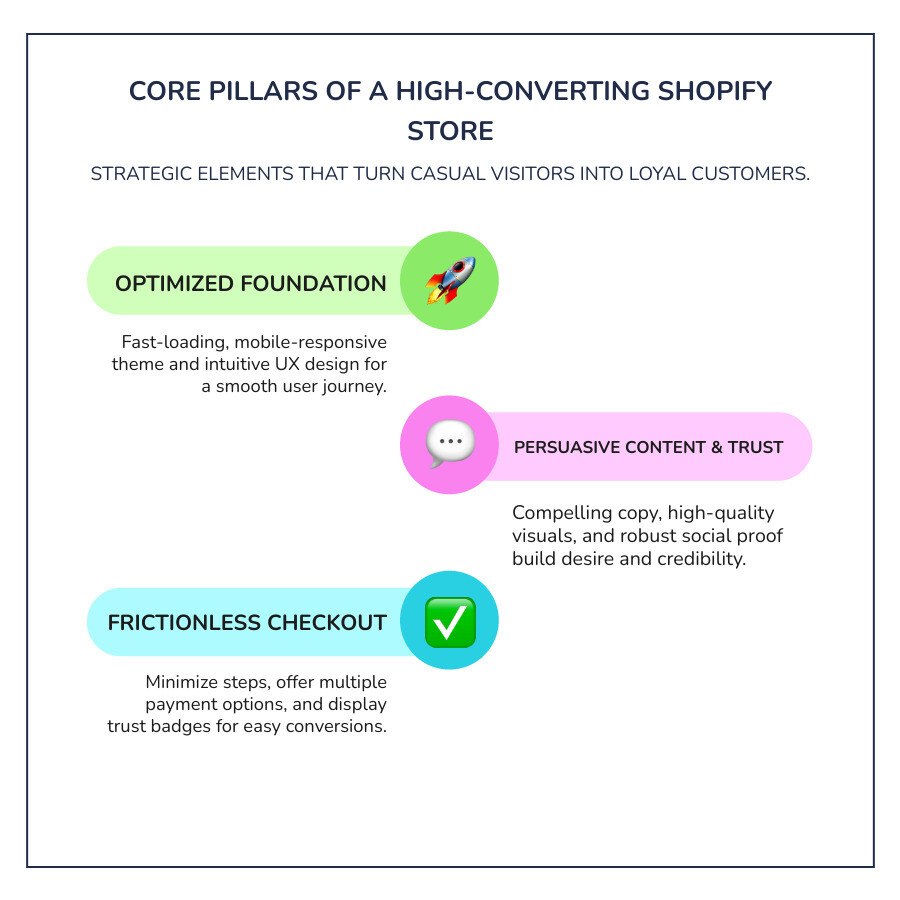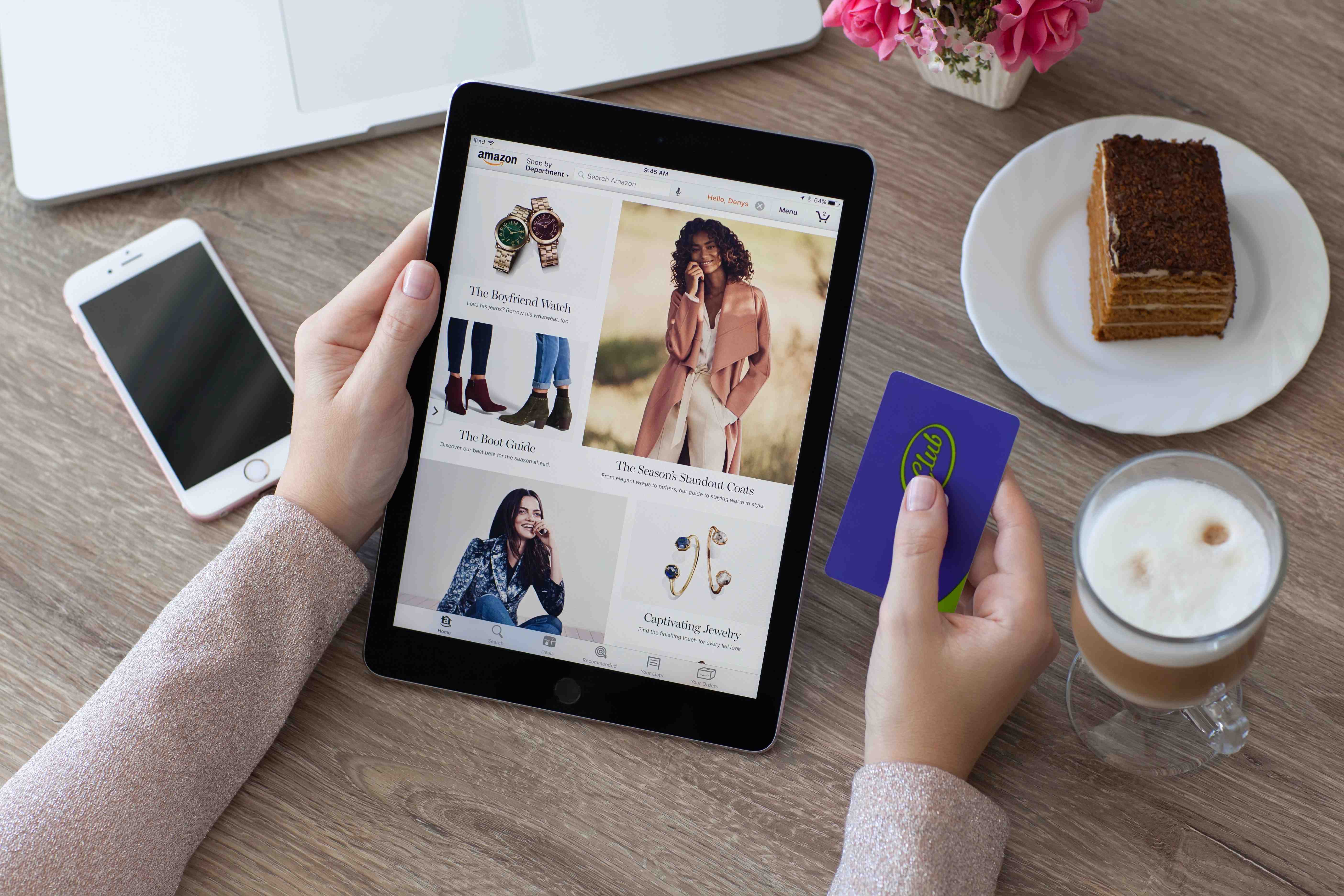Why Your Shopify Store's Performance Hinges on Conversion
A High-converting Shopify store turns casual browsers into paying customers. This is achieved through strategic design, a great user experience, and clear messaging. Key elements include a fast-loading, mobile-friendly theme, a clear value proposition, high-quality visuals, strong social proof, and a simple checkout process.
The difference between a store that converts at 2% versus one at 6% can mean hundreds of thousands of dollars in additional revenue. A landing page conversion rate of 6.6% is considered average in e-commerce, while anything above 10% is excellent. These numbers are the result of careful choices about theme, user experience, copywriting, and checkout optimization.
Your store's first impression matters. From the moment a visitor lands on your site, every element either moves them closer to a purchase or pushes them away. The best stores remove barriers, build trust, and make the path to purchase as clear and compelling as possible.
I'm Steve Pogson, and over my two decades building e-commerce businesses, I've helped countless brands transform their Shopify stores into experiences that drive revenue growth. At First Pier, we've partnered with leading brands to implement the exact strategies that turn traffic into sales.

Understanding the Foundations of a High-Converting Shopify Store
Building a High-converting Shopify store is about understanding how customers interact with your site and what motivates them to buy. Success comes from mastering a few fundamentals that create a seamless shopping experience.
What Defines a High-Converting Shopify Store?
A High-converting Shopify store excels at turning browsers into buyers. The key is that every element on your site guides visitors toward one specific action, whether it's buying a product or signing up for a newsletter. The path to that goal must be obvious. When stores offer too many choices, shoppers get overwhelmed and leave.
The average landing page conversion rate in e-commerce is around 6.6%. If you're hitting 10% or higher, you're in excellent territory. These rates are the result of understanding your customer and carefully optimizing every step. For proven tactics, check out our Increase Ecommerce Conversion Rate Guide.
The Critical Role of Your Shopify Theme
Your Shopify theme is more than just a pretty face; it's the foundation of your store. It determines page speed, ease of navigation, and ultimately, your conversion rate. A well-designed theme creates an effortless user experience, while a slow or clunky one will send customers running. Your site should load in under 2-3 seconds, as every extra second costs you sales.
With over half of online shopping happening on mobile devices, your theme must look stunning and function flawlessly on every screen size. The best themes also maintain unified branding across all devices, which builds trust and makes your store feel professional.
Your theme isn't just about looks—it's about creating a smooth path to purchase. For a deep look at how themes fit into your strategy, see our High-Converting Shopify Stores: The Ultimate Guide.
Essential Features of a Conversion-Focused Theme
When selecting a theme, I hunt for features that directly boost conversions. A conversion-focused theme must deliver on several fronts.
Fast loading times and mobile responsiveness are at the top of the list. A lightweight design ensures your pages appear instantly and adapt perfectly to any device. Built-in SEO features give you an advantage by making it easy to add titles, meta descriptions, and structured data, helping qualified traffic find you organically.
Your checkout process can make or break a sale, so a good theme streamlines this step. Don't overlook high-quality support from the theme developer for when challenges arise. For international customers, language and translation support can dramatically improve conversions.
Finally, look for conversion-oriented widgets like countdown timers, quick buy buttons, and trust badges. These small touches add up to significant improvements in your conversion rate. Choosing a theme with these features is the first step to success. For a complete rundown, grab our Shopify CRO Checklist.
Designing for Conversion: UX, Visuals, and Copywriting
With a solid theme in place, it's time to fill your store with content and design that speaks to your customers. This is where user experience, visuals, and persuasive words come together to create a High-converting Shopify store that drives sales.

Crafting a Value Proposition That Sells
Your value proposition is your core message. It must answer the question "What's in it for me?" within three seconds. A strong value proposition addresses a customer problem, presents your unique solution, and highlights the clear benefits.
For example, instead of "Portable Blender with 600W Motor," try "Healthy smoothies anytime, anywhere—no kitchen required." The second version connects with someone who wants convenience and health. This outcome-driven approach focuses on what customers gain, changing how they see your products. For more on structuring content, see our insights on Best Content for Ecommerce.
The Power of Compelling Copy and Storytelling
In a High-converting Shopify store, your copy builds relationships. Your brand voice should feel like a conversation with someone who understands your customer's needs. I've seen stores boost conversions by rewriting product descriptions to tell a story. Instead of listing features, paint a picture of the experience.
Your brand story should be woven throughout your site, from the About Us page to customer testimonials. This humanizes your business. Video is especially powerful for storytelling. Research from Wyzowl shows that 88% of people say they've been convinced to buy a product or service after watching a brand's video. If you're not using video, you're missing out on a key tool for building an emotional connection.
Optimizing Visuals and UX Design
Since people process images much faster than text, high-quality images are non-negotiable. Use professional product photos, lifestyle photos showing your products in use, and product videos to bring your items to life.
However, great images aren't enough. Your store's overall user experience must feel effortless. A clear visual hierarchy, smart use of white space, and intuitive navigation guide customers naturally toward a purchase. If visitors have to hunt for information or buttons, they'll leave. Every design choice should reduce friction and clarify the path to buying. For more guidance, look at our resources on Shopify Landing Page Design and Ecommerce Website Optimization.
Streamlining the User Experience: Reducing Friction and Building Trust
Even with a great product and design, customers can still leave your site due to friction or a lack of trust. My job is to identify and eliminate these roadblocks, making the path to purchase as smooth as possible.
Improving Cognitive Ease to Guide Buyers
Cognitive ease is about how simple it is for a visitor to process information on your site. The less mental effort required to understand your offer and how to buy, the higher your conversion rate. This is a powerful way to improve your High-converting Shopify store performance.
Several psychological principles can help. Urgency tactics (e.g., "Sale ends tonight!") and scarcity messages (e.g., "Only 3 left!") can motivate faster decisions, but they must be genuine. The framing effect is also powerful; presenting benefits positively ("95% fat-free" vs. "5% fat") is more appealing. By thoughtfully applying these principles, you make the decision-making process easier for customers, which is fundamental to Ecommerce Conversion Optimization.
How to Effectively Integrate Social Proof
People trust other people more than they trust marketing. That's why social proof is essential for a High-converting Shopify store. Customer reviews and ratings should be prominently displayed on product pages, especially photo reviews that show real people using your products.
Testimonials work best when they are specific and tell a story. User-generated content (UGC) from social media is marketing gold because of its authenticity. If your brand has been featured in reputable publications, display those media logos as trust signals. The same goes for genuine influencer endorsements. As McKinsey research shows, peer insights are highly influential in purchasing decisions.
Optimizing the Shopify Checkout Process
The checkout is the final hurdle where friction can cause high abandonment rates. For a High-converting Shopify store, the checkout must be smooth and reassuring.
First, minimize steps. Every extra click is a chance for a customer to leave. Always offer a guest checkout option, as forcing account creation is a major deterrent for new buyers. Providing multiple payment options like PayPal and Apple Pay caters to different preferences and reduces friction.
Display trust badges (SSL certificates, credit card logos) to reassure customers their information is safe. Be transparent with clear shipping costs and delivery estimates upfront to avoid last-minute surprises, a top reason for cart abandonment. Finally, use progress indicators (e.g., "Step 1 of 3") to manage expectations and reduce anxiety. A streamlined checkout is a cornerstone of any Shopify Sales Funnel and is key to Successful E-commerce Strategies.
Advanced Strategies for a High-Converting Shopify Store
Once you've mastered the basics, it's time to explore more sophisticated tactics to move the needle on your conversions. These strategies involve specialized approaches, testing, and making sure your store gets found.
The One-Product Store Model for Maximum Conversion
When shoppers face too many choices, they often buy nothing. The one-product store model solves this by focusing on a single hero product. This creates a refreshingly simple shopping experience, allows for laser-focused branding, and simplifies inventory management.
The key is choosing the right product. Entrepreneur Scott Hilse suggests finding something novel that looks great on video and isn't available in big box stores. Examples like BlendJet (portable blenders) and Snooz (sleep products) show how powerful this model can be. They use focused design and persuasive messaging to dominate their niche. This approach is a powerful part of any Ecommerce Growth Strategy.
Creating and Testing Your High-Converting Shopify Store Landing Pages
Landing pages are designed for one purpose: to get visitors to take a specific action. For a High-converting Shopify store, mastering landing pages is critical. Start by defining a single, clear goal. Craft a headline that communicates your value proposition, focusing on outcomes over features.
Your page needs high-quality visuals, social proof like reviews and testimonials, and a simple, low-friction design. But the work doesn't stop there. Use A/B testing tools like Shoplift or VWO to continuously improve performance. Test one element at a time—your headline, CTA button color, or main image—to identify what drives results. Ensure you're sending high-quality, interested traffic to the page, as poor traffic can skew results. This testing process is fundamental to any Shopify Ecommerce Growth Strategy and is covered in our guides on Shopify Landing Page Design and Shopify Marketing Strategies.
Using SEO Features to Boost Findability and Conversions
A perfectly optimized store is useless if no one can find it. That's why SEO is a conversion strategy, not just a traffic strategy. It attracts qualified visitors who are already searching for what you sell, making them more likely to buy.
Craft compelling SEO titles and meta descriptions with relevant keywords. Use descriptive image alt text to help search engines and improve accessibility. Site speed and mobile-friendliness are crucial for both user experience and Google's rankings. Use structured data (schema markup) to get rich snippets like star ratings in search results, making your listings more clickable. Finally, use internal linking to connect related products and content, which improves navigation and distributes authority across your site.
By focusing on these SEO elements, you ensure that visitors arriving at your store are already highly interested. For a complete walkthrough, see our Shopify SEO Guide.
Frequently Asked Questions about High-Converting Shopify Stores
I often get asked similar questions by store owners. Here are some of the most common ones, with the answers I've learned from years of experience.
What is a good conversion rate for a Shopify store?
There's no one-size-fits-all answer, as rates vary by industry, traffic quality, and product type. However, a landing page conversion rate of 6.6% is generally considered average for e-commerce. If your store is consistently converting above this, you're doing well. I've found that a rate of 10% or higher is excellent and indicates you've built a truly High-converting Shopify store.
It's always smart to measure against your specific niche, but aiming for that 10%+ mark is a worthy goal that can transform your revenue.
What makes a Shopify theme "high-converting"?
A high-converting theme isn't about flashy animations, which can slow down your site. Instead, it's defined by several key characteristics.
Fast load times are critical—ideally under 2-3 seconds. A mobile-first design is also non-negotiable, as most shopping now happens on phones. The theme must provide intuitive navigation and an optimized checkout process with minimal steps to prevent customers from abandoning their carts.
Finally, look for built-in conversion features like promotion timers, quick buy buttons, and trust badges. These elements encourage purchases without requiring custom coding. A high-converting theme removes obstacles and makes shopping feel effortless.
How can I quickly improve my Shopify store's conversion rate?
For quick conversion rate wins without a full redesign, focus on these high-impact areas:
First, add more social proof. Display customer reviews, testimonials, and user-generated photos prominently on your product pages. People trust other customers.
Next, improve your product photography and videos. Invest in professional, high-quality visuals from multiple angles. A short product video can be very persuasive, as 88% of people report being convinced to buy after watching one.
Simplify your navigation and write clearer calls to action (CTAs). Customers should never have to hunt for a button or wonder what to do next. Use action-oriented language like "Add to Cart" or "Get Yours Today."
Finally, optimize for mobile. Test your entire shopping experience on different phones to ensure it's smooth and frustration-free. These actions can produce noticeable results quickly. For more advice, see our How to Boost Ecommerce Sales guide.
To Sum Up: Your Next Steps to Higher Conversions
Building a High-converting Shopify store is an ongoing process. It requires constant attention and a commitment to keeping your customers at the heart of every decision.
Remember the key takeaways: a fast, mobile-responsive theme; a clear value proposition; copy and visuals that tell a story; intuitive navigation; and a low-friction checkout process built on trust and social proof. The most successful stores test relentlessly, analyze data, and adapt quickly. Even a small increase in your conversion rate can translate to significant revenue growth over time.
If you're unsure where to start, focus on quick wins: add more reviews, improve product photos, and simplify your checkout. These changes alone can make a big difference.
But sometimes you need a partner who has been through this experience hundreds of times. At First Pier, our award-winning e-commerce agency specializes in turning good Shopify stores into great ones. We can help you build strong Shopify foundations and create a scalable marketing strategy.
Our services include expert Shopify development, UX design, and creating a memorable branding identity. We drive growth through SEO, paid search, paid social, and powerful email and SMS marketing. Our core focus is on improving conversion rates and improving customer retention.
For scaling businesses, we handle everything from Shopify Plus optimization and subscription strategy to wholesale strategy and complex platform migrations. We use e-commerce data analytics to make informed decisions and manage technical details like Shopify automation and shipping optimization.
The path to a High-converting Shopify store is clearer than you might think. Start with one improvement, measure the results, then move to the next. And when you're ready for expert guidance, we're right here in Portland, Maine, ready to help you build something exceptional.







